Engineering
-
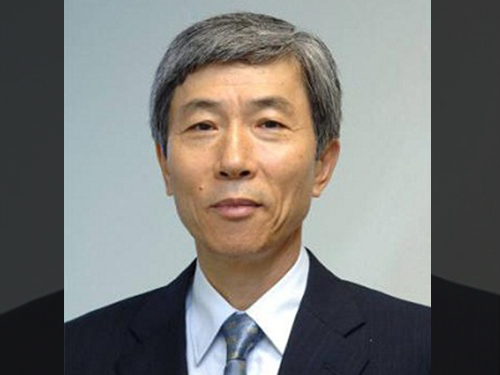 Professor Seok-Jung Kang Is Appointed the Director of the Korea Institute of Ceramic Engineering and Technology
Professor Seok-Jung Kang of the Material Sciences and Engineering Department at KAIST has been appointed to the position of the third Director of the Korea Institute of Ceramic Engineering and Technology. His three-year term will begin September 9, 2015.
An authority in the field of ceramics, Professor Kang has taught at KAIST since 1980. He received his bachelor’s degree from the Department of Metallurgical Engineering at Seoul National University, his master’s degree at KAIST, and his doctoral degree at the Ecole Centrale de Paris.
Professor Kang received the Robert B. Sosman Award in 2011, an annual prize given by the American Society of Ceramics to recognize outstanding achievement in basic science in an area that results in significant impact to the field of ceramics. He was the first Asian recipient of the award.
He also received the 2015 Professor Sir Richard Brooke Award, a prestigious bi-annual prize presented to an outstanding scholar by the European Society of Ceramics.
2015.09.15 View 7216
Professor Seok-Jung Kang Is Appointed the Director of the Korea Institute of Ceramic Engineering and Technology
Professor Seok-Jung Kang of the Material Sciences and Engineering Department at KAIST has been appointed to the position of the third Director of the Korea Institute of Ceramic Engineering and Technology. His three-year term will begin September 9, 2015.
An authority in the field of ceramics, Professor Kang has taught at KAIST since 1980. He received his bachelor’s degree from the Department of Metallurgical Engineering at Seoul National University, his master’s degree at KAIST, and his doctoral degree at the Ecole Centrale de Paris.
Professor Kang received the Robert B. Sosman Award in 2011, an annual prize given by the American Society of Ceramics to recognize outstanding achievement in basic science in an area that results in significant impact to the field of ceramics. He was the first Asian recipient of the award.
He also received the 2015 Professor Sir Richard Brooke Award, a prestigious bi-annual prize presented to an outstanding scholar by the European Society of Ceramics.
2015.09.15 View 7216 -
 KAIST's Doctoral Candidate Receives the 2015 Google Ph.D. Fellowship
Shin-Ae Woo, a doctoral student of Professor Su-Bok Moon of KAIST’s School of Computer Engineering, has received the 2015 Google Ph.D. Fellowship.
The fellowship’s term lasts one year, starting September 2015.
The fellowship awarded Ms. Woo with USD 10,000 of cash prize, an opportunity to meet a Google research mentor, and a summer internship at the company.
Created in 2009, the Google Ph.D. Fellowship annually recognizes outstanding doctoral students around the world in computer science and its related fields.
This year, a total of 44 doctoral students including Ms. Woo, who is studying networking and distributed system, have been nominated.
She has also received the NSDI (Networked Systems Design and Implementation) 2015 Community Award and the 2014 Samsung Human Technology Journal Silver Prize for her research work on “Design and Implementation of Highly Scalable User-level TCP Stack for Multicore Systems” and “Comparison of Caching Strategies in Modern Cellular Backhaul Networks.”
Currently, Ms. Woo is working with UC Berkeley faculty on next-generation data centers for a research exchange program.
2015.09.15 View 7441
KAIST's Doctoral Candidate Receives the 2015 Google Ph.D. Fellowship
Shin-Ae Woo, a doctoral student of Professor Su-Bok Moon of KAIST’s School of Computer Engineering, has received the 2015 Google Ph.D. Fellowship.
The fellowship’s term lasts one year, starting September 2015.
The fellowship awarded Ms. Woo with USD 10,000 of cash prize, an opportunity to meet a Google research mentor, and a summer internship at the company.
Created in 2009, the Google Ph.D. Fellowship annually recognizes outstanding doctoral students around the world in computer science and its related fields.
This year, a total of 44 doctoral students including Ms. Woo, who is studying networking and distributed system, have been nominated.
She has also received the NSDI (Networked Systems Design and Implementation) 2015 Community Award and the 2014 Samsung Human Technology Journal Silver Prize for her research work on “Design and Implementation of Highly Scalable User-level TCP Stack for Multicore Systems” and “Comparison of Caching Strategies in Modern Cellular Backhaul Networks.”
Currently, Ms. Woo is working with UC Berkeley faculty on next-generation data centers for a research exchange program.
2015.09.15 View 7441 -
 Professor Jeong Ho Lee Receives the 2015 Pediatric Epilepsies Research Award
The award identifies leading scientists worldwide and funds their cutting-edge research in epilepsy.
The Citizen United for Research in Epilepsy (CURE) announced on September 7, 2015, that Jeong Ho Lee, a professor of the Graduate School of Medical Science and Engineering at KAIST, will be awarded the 2015 Pediatric Epilepsies Research Award.
The Pediatric Epilepsies Research Award is given annually to a researcher who has conducted novel, innovative research projects that address severe, intractable pediatric epilepsies as well as collaborative, interdisciplinary projects that explore new approaches to find a treatment for pediatric epilepsies.
Lee was recognized for his leading study in the field of intractable epilepsy. He is the first Korean who has ever received this award, securing a research grant of USD 250,000 for two years.
Lee has conducted research on brain somatic mutations as the novel cause of childhood intractable epilepsy. Pediatric epilepsies account for approximately 70% of all cases of epilepsy.
Established in 1998, CURE is a non-profit American organization based in Chicago, Illinois, which is committed to funding research and various initiatives that will lead to breakthroughs to cure epilepsy.
Since its inception, CURE has been at the forefront of epilepsy research, raising more than USD 32 million to support researchers and scientists worldwide. It has also awarded more than 180 cutting-edge projects in 13 countries.
2015.09.09 View 11702
Professor Jeong Ho Lee Receives the 2015 Pediatric Epilepsies Research Award
The award identifies leading scientists worldwide and funds their cutting-edge research in epilepsy.
The Citizen United for Research in Epilepsy (CURE) announced on September 7, 2015, that Jeong Ho Lee, a professor of the Graduate School of Medical Science and Engineering at KAIST, will be awarded the 2015 Pediatric Epilepsies Research Award.
The Pediatric Epilepsies Research Award is given annually to a researcher who has conducted novel, innovative research projects that address severe, intractable pediatric epilepsies as well as collaborative, interdisciplinary projects that explore new approaches to find a treatment for pediatric epilepsies.
Lee was recognized for his leading study in the field of intractable epilepsy. He is the first Korean who has ever received this award, securing a research grant of USD 250,000 for two years.
Lee has conducted research on brain somatic mutations as the novel cause of childhood intractable epilepsy. Pediatric epilepsies account for approximately 70% of all cases of epilepsy.
Established in 1998, CURE is a non-profit American organization based in Chicago, Illinois, which is committed to funding research and various initiatives that will lead to breakthroughs to cure epilepsy.
Since its inception, CURE has been at the forefront of epilepsy research, raising more than USD 32 million to support researchers and scientists worldwide. It has also awarded more than 180 cutting-edge projects in 13 countries.
2015.09.09 View 11702 -
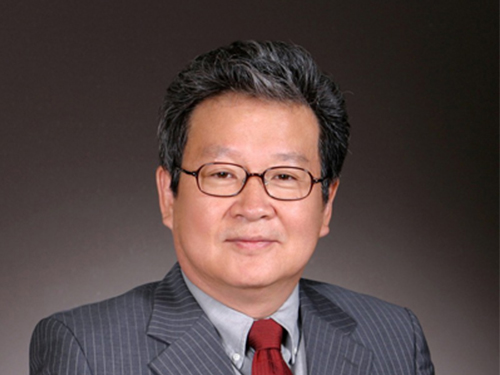 Professor Poong-Hyun Seong Appointed as the New President of the Korean Nuclear Society
Professor Poong-Hyun Seong of the Department of Nuclear and Quantum Engineering has been appointed as the 28th President of the Korean Nuclear Society (KNS). His presidency began on September 1, 2015 and will last one year.
Professor Seong graduated from the Department of Nuclear Engineering at Seoul National University, Korea, and received his master’s and doctoral degree at the Massachusetts Institute of Technology (MIT) in the United States.
He has filled various positions in the field of nuclear engineering, including a commissioner of the Nuclear Safety and Security Commission of Korea, manager of the Korean branch of the American Nuclear Society (ANS), and head of the Human Factors and Instrumentation and Controls Division of ANS.
At KNS, he served as the vice president as well as the Editor-in-Chief of its academic journal Nuclear Engineering and Technology.
The Korean Nuclear Society was established in 1969 to promote academic and technical research in nuclear engineering and develop safe and sustainable nuclear power. It is composed of more than 4,200 active members from ten research fields and has published the journal Nuclear Engineering and Technology since 2007.
2015.09.01 View 6724
Professor Poong-Hyun Seong Appointed as the New President of the Korean Nuclear Society
Professor Poong-Hyun Seong of the Department of Nuclear and Quantum Engineering has been appointed as the 28th President of the Korean Nuclear Society (KNS). His presidency began on September 1, 2015 and will last one year.
Professor Seong graduated from the Department of Nuclear Engineering at Seoul National University, Korea, and received his master’s and doctoral degree at the Massachusetts Institute of Technology (MIT) in the United States.
He has filled various positions in the field of nuclear engineering, including a commissioner of the Nuclear Safety and Security Commission of Korea, manager of the Korean branch of the American Nuclear Society (ANS), and head of the Human Factors and Instrumentation and Controls Division of ANS.
At KNS, he served as the vice president as well as the Editor-in-Chief of its academic journal Nuclear Engineering and Technology.
The Korean Nuclear Society was established in 1969 to promote academic and technical research in nuclear engineering and develop safe and sustainable nuclear power. It is composed of more than 4,200 active members from ten research fields and has published the journal Nuclear Engineering and Technology since 2007.
2015.09.01 View 6724 -
 KAIST's Research Team Receives the Best Paper Award from the IEEE Transaction on Power Electronics
A research team led by Professor Chun T. Rim of the Department of Nuclear and Quantum Engineering at the Korea Advanced Institute of Science and Technology (KAIST) has received the First Prize Papers Award from the IEEE (Institute of Electrical and Electronics Engineers) Transactions on Power Electronics (TPEL), a peer-reviewed journal that covers fundamental technologies used in the control and conversion of electric power.
A total of three research papers received this award in 2015.
Each year, TPEL’s editors select three best papers among those published in the journal during the preceding calendar year. In 2014, the TPEL published 579 papers. Professor Rim’s paper was picked out as one of the three papers published last year for the First Prize Papers Award.
Entitled “Generalized Active EMF (electromagnetic field) Cancel Methods for Wireless Electric Vehicles (http://ieeexplore.ieee.org/xpls/abs_all.jsp?arnumber=6684288&tag=1),” the paper proposed, for the first time in the world, three generalized design methods for cancelling the total EMF generated from wireless electric vehicles. This technology, researchers said, can be applied to any wireless power transfer systems.
The award ceremony will be held at the upcoming conference of the 2015 IEEE Energy Conversion Congress and Expo in September in Montreal, Canada.
2015.08.27 View 11708
KAIST's Research Team Receives the Best Paper Award from the IEEE Transaction on Power Electronics
A research team led by Professor Chun T. Rim of the Department of Nuclear and Quantum Engineering at the Korea Advanced Institute of Science and Technology (KAIST) has received the First Prize Papers Award from the IEEE (Institute of Electrical and Electronics Engineers) Transactions on Power Electronics (TPEL), a peer-reviewed journal that covers fundamental technologies used in the control and conversion of electric power.
A total of three research papers received this award in 2015.
Each year, TPEL’s editors select three best papers among those published in the journal during the preceding calendar year. In 2014, the TPEL published 579 papers. Professor Rim’s paper was picked out as one of the three papers published last year for the First Prize Papers Award.
Entitled “Generalized Active EMF (electromagnetic field) Cancel Methods for Wireless Electric Vehicles (http://ieeexplore.ieee.org/xpls/abs_all.jsp?arnumber=6684288&tag=1),” the paper proposed, for the first time in the world, three generalized design methods for cancelling the total EMF generated from wireless electric vehicles. This technology, researchers said, can be applied to any wireless power transfer systems.
The award ceremony will be held at the upcoming conference of the 2015 IEEE Energy Conversion Congress and Expo in September in Montreal, Canada.
2015.08.27 View 11708 -
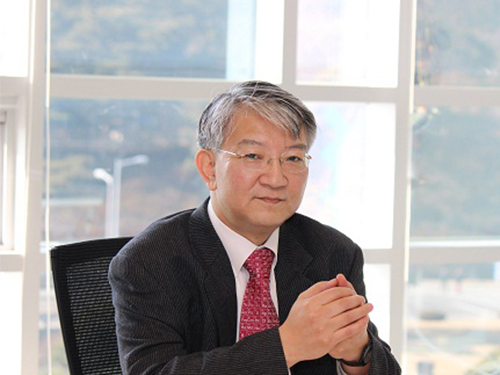 Nature Biotechnology Nominates Sang Yup Lee of KAIST for Top 20 Translational Researchers of 2014
Nature Biotechnology, recognized as the most prestigious journal in the field of biotechnology, has released today its list of the Top 20 Translational Researchers of 2014. Distinguished Professor Sang Yup Lee of the Department of Chemical and Biomolecular Engineering at KAIST (Korea Advanced Institute of Science and Technology) ranked seventh in the list. He is the only Asian researcher listed.
The journal, in partnership with IP Checkups, a patent analytics firm, presents an annual ranking of researchers based on their paper and patent output. The list includes, among others, each researcher’s most-cited patent in the past five years and their H index, a measurement to evaluate the impact of a researcher’s published work utilizing citation analysis. (More details can be found at http://www.nature.com/bioent/2015/150801/full/bioe.2015.9.html.)
American institutions made up the majority of the list, with 18 universities and research institutes, and the remainder was filled by KAIST in Korea and the Commonwealth Scientific and Industrial Research Organization (CSIRO) in Australia.
Globally known as a leading researcher in systems metabolic engineering, Professor Lee has published more than 500 journal papers and 580 patents. He has received many awards, including the Citation Classic Award, Elmer Gaden Award, Merck Metabolic Engineering Award, ACS Marvin Johnson Award, SIMB Charles Thom Award, POSCO TJ Park Prize, Amgen Biochemical Engineering Award, and the Ho Am Prize in Engineering.
2015.08.27 View 11628
Nature Biotechnology Nominates Sang Yup Lee of KAIST for Top 20 Translational Researchers of 2014
Nature Biotechnology, recognized as the most prestigious journal in the field of biotechnology, has released today its list of the Top 20 Translational Researchers of 2014. Distinguished Professor Sang Yup Lee of the Department of Chemical and Biomolecular Engineering at KAIST (Korea Advanced Institute of Science and Technology) ranked seventh in the list. He is the only Asian researcher listed.
The journal, in partnership with IP Checkups, a patent analytics firm, presents an annual ranking of researchers based on their paper and patent output. The list includes, among others, each researcher’s most-cited patent in the past five years and their H index, a measurement to evaluate the impact of a researcher’s published work utilizing citation analysis. (More details can be found at http://www.nature.com/bioent/2015/150801/full/bioe.2015.9.html.)
American institutions made up the majority of the list, with 18 universities and research institutes, and the remainder was filled by KAIST in Korea and the Commonwealth Scientific and Industrial Research Organization (CSIRO) in Australia.
Globally known as a leading researcher in systems metabolic engineering, Professor Lee has published more than 500 journal papers and 580 patents. He has received many awards, including the Citation Classic Award, Elmer Gaden Award, Merck Metabolic Engineering Award, ACS Marvin Johnson Award, SIMB Charles Thom Award, POSCO TJ Park Prize, Amgen Biochemical Engineering Award, and the Ho Am Prize in Engineering.
2015.08.27 View 11628 -
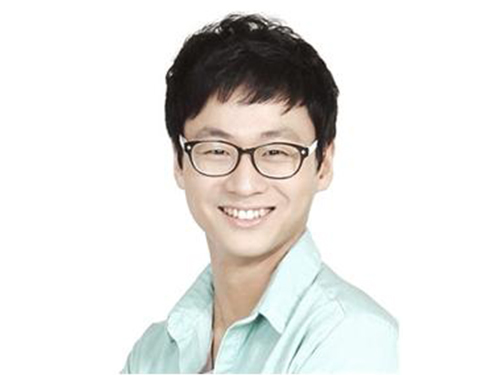 Dr. Hyundoo Hwang Receives a Tenured Position at Monterrey Institute of Technology and Higher Education
Hyundoo Hwang, a former graduate student in the Department of Bio & Brain Engineering at KAIST, has been granted a tenured position at the Monterrey Institute of Technology and Higher Education (ITSEM), Mexico.
Dr. Hwang received his bachelor’s, master’s, and doctoral degree at KAIST and started his professorship at Ulsan National Institute of Science & Technology (UNIST) in Korea. He continued his research in the United States as a professor at Georgia Institute of Technology. He has been acknowledged for the development of an advanced nanotechnology for the diagnosis of rare diseases and research in cell signals. He is one of the leading researchers in an international research project in microelectromechanical systems (MEMS) with participation by researchers from over ten countries. He has been active in commercializing biosensor technology in the U.S. and Mexico.
Since its establishment in 1943, ITSEM has grown to 33 campuses in 25 cities in Mexico. It is the largest university in Latin America with over 90,000 students (47% of its graduate students has oversea research experience). It recruits over 5,000 international students and professors every year.
Dr. Hwang will begin teaching at ITSEM as a professor in the Department of Biomedical Engineering (Ingeniería Biomédica) this fall. He will also conduct research in nano- and micro-technology as a member of Sensors and Devices research group.
Professor Gwang Hyun Cho, head of KAIST's Department of Bio and Brain Engineering said that Dr. Hwang’s tenure professorship at ITSEM demonstrated that the academic program at KAIST—from undergraduate to doctoral—was on par with the international standard. He hoped that more talents from the department would seek academic careers in internationally renowned universities around the world.
2015.08.13 View 7577
Dr. Hyundoo Hwang Receives a Tenured Position at Monterrey Institute of Technology and Higher Education
Hyundoo Hwang, a former graduate student in the Department of Bio & Brain Engineering at KAIST, has been granted a tenured position at the Monterrey Institute of Technology and Higher Education (ITSEM), Mexico.
Dr. Hwang received his bachelor’s, master’s, and doctoral degree at KAIST and started his professorship at Ulsan National Institute of Science & Technology (UNIST) in Korea. He continued his research in the United States as a professor at Georgia Institute of Technology. He has been acknowledged for the development of an advanced nanotechnology for the diagnosis of rare diseases and research in cell signals. He is one of the leading researchers in an international research project in microelectromechanical systems (MEMS) with participation by researchers from over ten countries. He has been active in commercializing biosensor technology in the U.S. and Mexico.
Since its establishment in 1943, ITSEM has grown to 33 campuses in 25 cities in Mexico. It is the largest university in Latin America with over 90,000 students (47% of its graduate students has oversea research experience). It recruits over 5,000 international students and professors every year.
Dr. Hwang will begin teaching at ITSEM as a professor in the Department of Biomedical Engineering (Ingeniería Biomédica) this fall. He will also conduct research in nano- and micro-technology as a member of Sensors and Devices research group.
Professor Gwang Hyun Cho, head of KAIST's Department of Bio and Brain Engineering said that Dr. Hwang’s tenure professorship at ITSEM demonstrated that the academic program at KAIST—from undergraduate to doctoral—was on par with the international standard. He hoped that more talents from the department would seek academic careers in internationally renowned universities around the world.
2015.08.13 View 7577 -
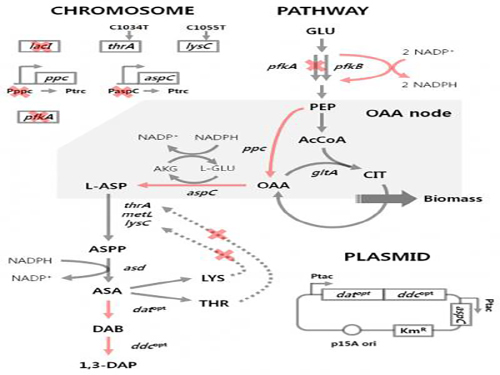 'Engineered Bacterium Produces 1,3-Diaminopropane'
A research team led by Distinguished Professor Sang Yup Lee of the Department of Chemical and Biomolecular Engineering at KAIST reported, for the first time, the production of 1,3-diaminopropane via fermentation of an engineered bacterium.
1,3-Diaminopropane is a three carbon diamine, which has a wide range of industrial applications including epoxy resin and cross-linking agents, as well as precursors for pharmaceuticals, agrochemicals, and organic chemicals. It can also be polymerized with dicarboxylic acids to make polyamides (nylons) for use as engineering plastics, medical materials, and adhesives.
Traditionally, 1,3-diaminopropane is derived from petroleum-based processes. In effort to address critical problems such as the depletion of petroleum and environmental issues inherent to the petroleum-based processes, the research team has developed an Escherichia coli (E. coli) strain capable of producing 1,3-diaminopropane. Using this technology, 1,3-diaminopropane can now be produced from renewable biomass instead of petroleum.
E. coli as found in nature is unable to produce 1,3-diaminopropane. Metabolic engineering, a technology to transform microorganisms into highly efficient microbial cell factories capable of producing chemical compounds of interest, was utilized to engineer the E. coli strain. First, naturally existing metabolic pathways for the biosynthesis of 1,3-diaminopropane were introduced into a virtual cell in silico to determine the most efficient metabolic pathway for the 1,3-diaminopropane production. The metabolic pathway selected was then introduced into an E. coli strain and successfully produced 1,3-diaminopropane for the first time in the world.
The research team applied metabolic engineering additionally, and the production titer of 1,3-diaminopropane increased about 21 fold. The Fed-batch fermentation of the engineered E. coli strain produced 13 grams per liter of 1,3-diaminoproapne. With this technology, 1,3-diaminopropane can be produced using renewable biomass, and it will be the starting point for replacing the current petroleum-based processes with bio-based processes.
Professor Lee said, “Our study suggested a possibility to produce 1,3-diaminopropane based on biorefinery. Further study will be done to increase the titer and productivity of 1,3-diaminopropane.”
This work was published online in Scientific Reports on August 11, 2015.
Reference: Chae, T.U. et al. "Metabolic engineering of Escherichia coli for the production of 1,3-diaminopropane, a three carbon diamine," Scientific Reports:
http://www.nature.com/articles/srep13040
This research was supported by the Technology Development Program to Solve Climate Changes on Systems Metabolic Engineering for Biorefineries from Ministry of Science, ICT and Future Planning (MSIP) through the National Research Foundation (NRF) of Korea.
Figure 1: Metabolic engineering strategies for 1,3-diaminopropane production using C4 pathway
Figure 2: Fed-batch fermentation profiles of two final engineered E. coli strains
2015.08.12 View 11691
'Engineered Bacterium Produces 1,3-Diaminopropane'
A research team led by Distinguished Professor Sang Yup Lee of the Department of Chemical and Biomolecular Engineering at KAIST reported, for the first time, the production of 1,3-diaminopropane via fermentation of an engineered bacterium.
1,3-Diaminopropane is a three carbon diamine, which has a wide range of industrial applications including epoxy resin and cross-linking agents, as well as precursors for pharmaceuticals, agrochemicals, and organic chemicals. It can also be polymerized with dicarboxylic acids to make polyamides (nylons) for use as engineering plastics, medical materials, and adhesives.
Traditionally, 1,3-diaminopropane is derived from petroleum-based processes. In effort to address critical problems such as the depletion of petroleum and environmental issues inherent to the petroleum-based processes, the research team has developed an Escherichia coli (E. coli) strain capable of producing 1,3-diaminopropane. Using this technology, 1,3-diaminopropane can now be produced from renewable biomass instead of petroleum.
E. coli as found in nature is unable to produce 1,3-diaminopropane. Metabolic engineering, a technology to transform microorganisms into highly efficient microbial cell factories capable of producing chemical compounds of interest, was utilized to engineer the E. coli strain. First, naturally existing metabolic pathways for the biosynthesis of 1,3-diaminopropane were introduced into a virtual cell in silico to determine the most efficient metabolic pathway for the 1,3-diaminopropane production. The metabolic pathway selected was then introduced into an E. coli strain and successfully produced 1,3-diaminopropane for the first time in the world.
The research team applied metabolic engineering additionally, and the production titer of 1,3-diaminopropane increased about 21 fold. The Fed-batch fermentation of the engineered E. coli strain produced 13 grams per liter of 1,3-diaminoproapne. With this technology, 1,3-diaminopropane can be produced using renewable biomass, and it will be the starting point for replacing the current petroleum-based processes with bio-based processes.
Professor Lee said, “Our study suggested a possibility to produce 1,3-diaminopropane based on biorefinery. Further study will be done to increase the titer and productivity of 1,3-diaminopropane.”
This work was published online in Scientific Reports on August 11, 2015.
Reference: Chae, T.U. et al. "Metabolic engineering of Escherichia coli for the production of 1,3-diaminopropane, a three carbon diamine," Scientific Reports:
http://www.nature.com/articles/srep13040
This research was supported by the Technology Development Program to Solve Climate Changes on Systems Metabolic Engineering for Biorefineries from Ministry of Science, ICT and Future Planning (MSIP) through the National Research Foundation (NRF) of Korea.
Figure 1: Metabolic engineering strategies for 1,3-diaminopropane production using C4 pathway
Figure 2: Fed-batch fermentation profiles of two final engineered E. coli strains
2015.08.12 View 11691 -
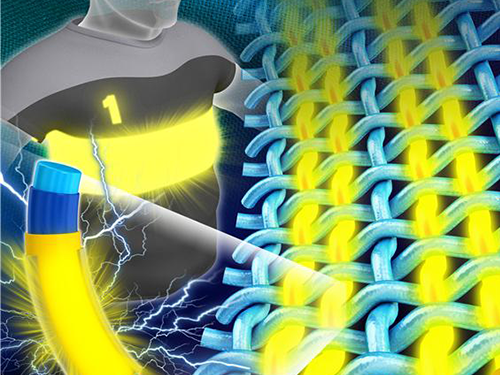 KAIST Develops Fiber-Like Light-Emitting Diodes for Wearable Displays
Professor Kyung-Cheol Choi and his research team from the School of Electrical Engineering at KAIST have developed fiber-like light-emitting diodes (LEDs), which can be applied in wearable displays. The research findings were published online in the July 14th issue of Advanced Electronic Materials.
Traditional wearable displays were manufactured on a hard substrate, which was later attached to the surface of clothes. This technique had limited applications for wearable displays because they were inflexible and ignored the characteristics of fabric.
To solve this problem, the research team discarded the notion of creating light-emitting diode displays on a plane. Instead, they focused on fibers, a component of fabrics, and developed a fiber-like LED that shared the characteristics of both fabrics and displays.
The essence of this technology, the dip-coating process, is to immerse and extract a three dimensional (3-D) rod (a polyethylene terephthalate fiber) from a solution, which functions like thread. Then, the regular levels of organic materials are formed as layers on the thread.
The dip-coating process allows the layers of organic materials to be easily created on the fibers with a 3-D cylindrical structure, which had been difficult in existing processes such as heat-coating process. By controlling of the withdrawal rate of the fiber, the coating's thickness can also be adjusted to the hundreds of thousandths of a nanometer.
The researchers said that this technology would accelerate the commercialization of fiber-based wearable displays because it offers low-cost mass production using roll-to-roll processing, a technology applied to create electronic devices on a roll of flexible plastics or metal foils.
Professor Choi said, “Our research will become a core technology in developing light emitting diodes on fibers, which are fundamental elements of fabrics. We hope we can lower the barrier of wearable displays entering the market.”
The lead author of the published paper, Seon-Il Kwon, added, “This technology will eventually allow the production of wearable displays to be as easy as making clothes.”
Picture 1: The Next Generation Wearable Display Using Fiber-Based Light-Emitting Diodes
Picture 2: Dip-Coating Process to Create Fiber-Based Light-Emitting Diodes
Picture 3: Fiber-Based Light-Emitting Diodes
2015.08.11 View 13640
KAIST Develops Fiber-Like Light-Emitting Diodes for Wearable Displays
Professor Kyung-Cheol Choi and his research team from the School of Electrical Engineering at KAIST have developed fiber-like light-emitting diodes (LEDs), which can be applied in wearable displays. The research findings were published online in the July 14th issue of Advanced Electronic Materials.
Traditional wearable displays were manufactured on a hard substrate, which was later attached to the surface of clothes. This technique had limited applications for wearable displays because they were inflexible and ignored the characteristics of fabric.
To solve this problem, the research team discarded the notion of creating light-emitting diode displays on a plane. Instead, they focused on fibers, a component of fabrics, and developed a fiber-like LED that shared the characteristics of both fabrics and displays.
The essence of this technology, the dip-coating process, is to immerse and extract a three dimensional (3-D) rod (a polyethylene terephthalate fiber) from a solution, which functions like thread. Then, the regular levels of organic materials are formed as layers on the thread.
The dip-coating process allows the layers of organic materials to be easily created on the fibers with a 3-D cylindrical structure, which had been difficult in existing processes such as heat-coating process. By controlling of the withdrawal rate of the fiber, the coating's thickness can also be adjusted to the hundreds of thousandths of a nanometer.
The researchers said that this technology would accelerate the commercialization of fiber-based wearable displays because it offers low-cost mass production using roll-to-roll processing, a technology applied to create electronic devices on a roll of flexible plastics or metal foils.
Professor Choi said, “Our research will become a core technology in developing light emitting diodes on fibers, which are fundamental elements of fabrics. We hope we can lower the barrier of wearable displays entering the market.”
The lead author of the published paper, Seon-Il Kwon, added, “This technology will eventually allow the production of wearable displays to be as easy as making clothes.”
Picture 1: The Next Generation Wearable Display Using Fiber-Based Light-Emitting Diodes
Picture 2: Dip-Coating Process to Create Fiber-Based Light-Emitting Diodes
Picture 3: Fiber-Based Light-Emitting Diodes
2015.08.11 View 13640 -
 Professor Sang-Min Bae Receives the 2015 Red Dot Design Award
Professor Sang-Min Bae and his research team from the Industrial Design Department of KAIST have received three awards from the 2015 Red Dot Design Award: the Best of the Best Award and two Design Concept Awards.
Being one of the most prestigious international design awards, the Red Dot Design Award serves to identify good design concept and innovation that will be the precursors of tomorrow’s great product. Its annual award ceremony will take place on September 25, 2015, at the Red Dot Design Museum in Singapore.
This year, the Award received 4,680 entries from 61 countries, and only the top 5.7% of them was able to garner the awards. In addition to two Red Dot Design Concept Awards, Professor Bae’s team won the Best of the Best Award, coming through a four hundred to one competition.
Awarded the Best of the Best Award, Boxchool is a modular classroom built on shipping containers whose aim is to give underprivileged children equal opportunities for learning. Jointly designed with an IT corporation in Korea, SK Telecom, the container is also a smart classroom.
Boxchool received the Best of the Best Award in recognition of its contribution to giving an equal learning opportunity to needy children, as well as its environmental characteristics.
The research team strengthened the mobility of the container and creatively addressed problems associated with using containers as classrooms such as insulation and inadequate space in environments which hamper teaching. The modular classroom can function in any setting since it can generate electricity from installed solar panels. The rainwater utilization system allows autonomous operation of the classroom.
The team earned the Red Dot Design Concept Award for a self-generating interactive tent, which was jointly designed with Kolon Sport, a Korean outdoor products company, as an industry-university cooperation project. The interactive tent differs from conventional tents by adding features that allow users to engage with the environment. For example, the installed organic solar cells allowed users to have prolonged outdoor activities by supplying electricity generated therefrom. Users can also enjoy greater ventilation. This permits the tent to be utilized as a temporary residence in the third world.
Another recipient of the Red Dot Design Concept Award, Snow Energy is a portable self-generating lamp and charger, which contains a thermo-element, generating electricity from temperature difference. Electricity is generated by pouring hot water inside a tank and cold water into a neighboring space. Snow Energy, which is sustainable and eco-friendly, will be especially helpful during outdoor activities when there is no electricity available.
Professor Bae's research team, ID+IM, has endeavored to address inequality and philanthropy through two projects, the Nanum (a Korean word to mean “sharing”) and the Seed Projects. Since 2005, they have received internationally recognized awards more than 40 times.
Picture 1: Recipient of the Best of the Best Award of the 2015 Red Dot Design Award, Boxchool is a modular classroom built on shipping containers
Picture 2: Recipient of the 2015 Red Dot Design Concept Award, the self-generating interactive tent
Picture 3: Recipient of the 2015 Red Dot Design Concept Award, Snow Energy is a portable self-generating lamp and charger which generates electricity from the temperature difference
2015.08.05 View 11937
Professor Sang-Min Bae Receives the 2015 Red Dot Design Award
Professor Sang-Min Bae and his research team from the Industrial Design Department of KAIST have received three awards from the 2015 Red Dot Design Award: the Best of the Best Award and two Design Concept Awards.
Being one of the most prestigious international design awards, the Red Dot Design Award serves to identify good design concept and innovation that will be the precursors of tomorrow’s great product. Its annual award ceremony will take place on September 25, 2015, at the Red Dot Design Museum in Singapore.
This year, the Award received 4,680 entries from 61 countries, and only the top 5.7% of them was able to garner the awards. In addition to two Red Dot Design Concept Awards, Professor Bae’s team won the Best of the Best Award, coming through a four hundred to one competition.
Awarded the Best of the Best Award, Boxchool is a modular classroom built on shipping containers whose aim is to give underprivileged children equal opportunities for learning. Jointly designed with an IT corporation in Korea, SK Telecom, the container is also a smart classroom.
Boxchool received the Best of the Best Award in recognition of its contribution to giving an equal learning opportunity to needy children, as well as its environmental characteristics.
The research team strengthened the mobility of the container and creatively addressed problems associated with using containers as classrooms such as insulation and inadequate space in environments which hamper teaching. The modular classroom can function in any setting since it can generate electricity from installed solar panels. The rainwater utilization system allows autonomous operation of the classroom.
The team earned the Red Dot Design Concept Award for a self-generating interactive tent, which was jointly designed with Kolon Sport, a Korean outdoor products company, as an industry-university cooperation project. The interactive tent differs from conventional tents by adding features that allow users to engage with the environment. For example, the installed organic solar cells allowed users to have prolonged outdoor activities by supplying electricity generated therefrom. Users can also enjoy greater ventilation. This permits the tent to be utilized as a temporary residence in the third world.
Another recipient of the Red Dot Design Concept Award, Snow Energy is a portable self-generating lamp and charger, which contains a thermo-element, generating electricity from temperature difference. Electricity is generated by pouring hot water inside a tank and cold water into a neighboring space. Snow Energy, which is sustainable and eco-friendly, will be especially helpful during outdoor activities when there is no electricity available.
Professor Bae's research team, ID+IM, has endeavored to address inequality and philanthropy through two projects, the Nanum (a Korean word to mean “sharing”) and the Seed Projects. Since 2005, they have received internationally recognized awards more than 40 times.
Picture 1: Recipient of the Best of the Best Award of the 2015 Red Dot Design Award, Boxchool is a modular classroom built on shipping containers
Picture 2: Recipient of the 2015 Red Dot Design Concept Award, the self-generating interactive tent
Picture 3: Recipient of the 2015 Red Dot Design Concept Award, Snow Energy is a portable self-generating lamp and charger which generates electricity from the temperature difference
2015.08.05 View 11937 -
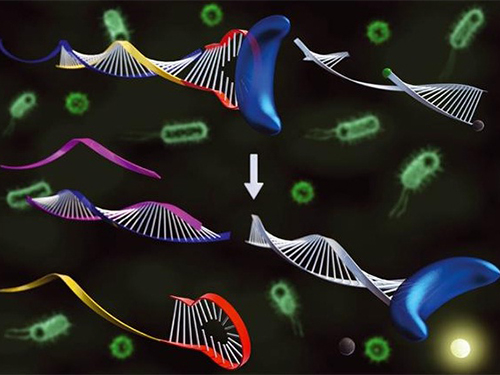 Affordable Genetic Diagnostic Technique for Target DNA Analysis Developed
Professor Hyun-Gyu Park of the Department of Chemical and Biomolecular Engineering at KAIST has developed a technique to analyze various target DNAs using an aptamer, a DNA fragment that can recognize and bind to a specific protein or enzyme. This technique will allow the development of affordable genetic diagnoses for new bacteria or virus, such as Middle Ease Respiratory Syndrome (MERS). The research findings were published in the June issue of Chemical Communications, issued by the Royal Society of Chemistry in the United Kingdom. The paper was selected as a lead article of the journal.
The existing genetic diagnosis technique, based on molecular beacon probes, requires a new beacon probe whenever a target DNA mutates. As a result, it was costly to analyze various target DNA fragments. To address this problem, Professor Park’s team designed an aptamer that binds and deactivates DNA polymerase. The technique was used in reverse, so that the aptemer did not bind to the polymerase, maintaining its activated state, only if the target DNA was present. These probes are called TagMan probes.
The controlled activation and deactivation of DNA polymerase enables nucleic acid to elongate or dwindle, making it possible to measure fluorescence signals coming from TaqMan probes. This same probe can be used to detect various target DNAs, leading to the development of a new and sensitive genetic diagnostic technique.
Unlike the existing molecular beacon probe technique which requires a new probe for every target DNA, this new technique uses the same fluorescent TaqMan probe, which is cheaper and easier to detect a number of different target nucleic acid fragments. The application of this technique will make the process of identifying and detecting foreign DNAs from pathogens such as virus and bacteria more affordable and simple.
Professor Park said, “This technique will enable us to develop simpler diagnostic kits for new pathogens, such as MERS, allowing a faster response to various diseases. Our technology can also be applied widely in the field of genetic diagnostics.”
Picture: A schematic image of target nucleic acid extracted through the activation and deactivation of DNA polymerase
2015.07.31 View 10816
Affordable Genetic Diagnostic Technique for Target DNA Analysis Developed
Professor Hyun-Gyu Park of the Department of Chemical and Biomolecular Engineering at KAIST has developed a technique to analyze various target DNAs using an aptamer, a DNA fragment that can recognize and bind to a specific protein or enzyme. This technique will allow the development of affordable genetic diagnoses for new bacteria or virus, such as Middle Ease Respiratory Syndrome (MERS). The research findings were published in the June issue of Chemical Communications, issued by the Royal Society of Chemistry in the United Kingdom. The paper was selected as a lead article of the journal.
The existing genetic diagnosis technique, based on molecular beacon probes, requires a new beacon probe whenever a target DNA mutates. As a result, it was costly to analyze various target DNA fragments. To address this problem, Professor Park’s team designed an aptamer that binds and deactivates DNA polymerase. The technique was used in reverse, so that the aptemer did not bind to the polymerase, maintaining its activated state, only if the target DNA was present. These probes are called TagMan probes.
The controlled activation and deactivation of DNA polymerase enables nucleic acid to elongate or dwindle, making it possible to measure fluorescence signals coming from TaqMan probes. This same probe can be used to detect various target DNAs, leading to the development of a new and sensitive genetic diagnostic technique.
Unlike the existing molecular beacon probe technique which requires a new probe for every target DNA, this new technique uses the same fluorescent TaqMan probe, which is cheaper and easier to detect a number of different target nucleic acid fragments. The application of this technique will make the process of identifying and detecting foreign DNAs from pathogens such as virus and bacteria more affordable and simple.
Professor Park said, “This technique will enable us to develop simpler diagnostic kits for new pathogens, such as MERS, allowing a faster response to various diseases. Our technology can also be applied widely in the field of genetic diagnostics.”
Picture: A schematic image of target nucleic acid extracted through the activation and deactivation of DNA polymerase
2015.07.31 View 10816 -
 KAIST Operates a Summer School with Imperial College London
KAIST and Imperial College London jointly hosted a summer school on the KAIST campus on July 14-17, 2015. Twenty-five students from both universities, 11 from KAIST and 14 from Imperial College, participated in the summer program.
KAIST and Imperial College agreed to hold academic and research exchange programs in 2013; this year’s summer school represented the first effort.
Participants were divided into a few cohorts of four or five students. They conducted a series of activities to implement joint research projects involving team building, networking, joint study, discussions, and presentations.
Among the projects the summer school ran, Professor Hoi-Jun Yoo of the Electrical Engineering Department at KAIST was invited to teach students about the mobile healthcare system, Dr. M, that he had developed.
Sung-Hyon Myaeng, Associate Vice President of the International Affairs Office, KAIST, said, “This summer school is yet another example of KAIST’s ongoing efforts to make the campus more global and to interact actively with members of the international community.”
2015.07.29 View 8857
KAIST Operates a Summer School with Imperial College London
KAIST and Imperial College London jointly hosted a summer school on the KAIST campus on July 14-17, 2015. Twenty-five students from both universities, 11 from KAIST and 14 from Imperial College, participated in the summer program.
KAIST and Imperial College agreed to hold academic and research exchange programs in 2013; this year’s summer school represented the first effort.
Participants were divided into a few cohorts of four or five students. They conducted a series of activities to implement joint research projects involving team building, networking, joint study, discussions, and presentations.
Among the projects the summer school ran, Professor Hoi-Jun Yoo of the Electrical Engineering Department at KAIST was invited to teach students about the mobile healthcare system, Dr. M, that he had developed.
Sung-Hyon Myaeng, Associate Vice President of the International Affairs Office, KAIST, said, “This summer school is yet another example of KAIST’s ongoing efforts to make the campus more global and to interact actively with members of the international community.”
2015.07.29 View 8857